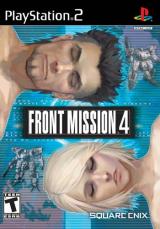Square's long-running Front Mission mech strategy series is set to return once again. Front Mission 4 takes place six years after the last game. The year is 2096, and the world is divided into three superpowers, a united Europe (the "E.C."), a pan-American union (the "U.C.S."), and an Asian alliance (the "O.C.U."). The battlefields of this future are dominated by wanzers. Wanzers are mechas, giant robots. Except they're called wanzers. It's the future, so everything gets a fancy name … even if it already has a perfectly good one. But hey, wanzers are whatever the future word for awesome is, so we should all be happy.
The storyline is a little bit sketchy at this point, but it involves two separate plot threads. The first is focused on Elsa, a French woman and a talented new recruit into the E.C.'s Durandal Corps. The second features Darril, a U.C.S. soldier happy to be in the rear guard. Elsa's unit has to contend with a surprise attack by an unknown enemy on an E.C. base in Germany, while Darril and his two friends stumble upon a once-in-a-lifetime opportunity in Venezuela during some political upheaval. It's unknown whether or not their paths will cross, but at the very least it looks like the game's story has the same potential for twists as its predecessor.
The basic mechanics of the game will be very familiar to those who've played the previous game. Turns are divided into friendly and enemy phases. Each wanzer on your team has a limited amount of AP (Action Points) with which to move and then fire. Sufficient leftover AP can be used to counterattack, if a unit is attacked during the enemy's phase. The basic weapon types haven't changed, either. Wanzers can be equipped with melee weapons, shotguns, machineguns, long-range rifles, missiles, and grenade launchers. Each weapon inflicts one of three types of damage: impact, piercing, or fire. Each wanzer can be outfitted with armor to reduce damage from one of those types by 30%. A wanzer's arm can also be equipped with a shield, which can be used as a type of counterattack that reduces damage from an assault.
The basic composition of a wanzer also remains the same: the body, two arms, and a set of legs. The body is the power source and the arms are the mount points for weapons. The three leg types, two legs, four legs, and hover each have advantages and disadvantages over different types of terrain. For instance, hover wanzers can move quickly over water and can even move into squares with deep water, but they can't climb steep hills or jump onto platforms (unless also equipped with a jet pack). In addition to the arm-mounted weapons, wanzers can equip a backpack which can be used to carry items like repair kits or spare ammo, or to boost the wanzer's power rating, giving a wanzer either capacity for an extra weapon or giving a boost to the attacks of one more lightly equipped. New to Front Mission 4 are repair and EMP backpacks, which allow a pilot to repair an ally at range (even restoring destroyed limbs) or attempt to shut down an enemy temporarily with a targeted electro-magnetic pulse.
By far the biggest change to the game's mechanics is the addition of the "Link System." When you give a mech an attack command, its allies that also have the target in range have the opportunity to attack as well, even if they've already attacked that turn, as long as they have ammo and AP. In its current state, it seems to unbalance the game in favor of melee weapons. Since a punch only uses one AP, moving a melee wanzer into position early in the round can yield many more linked attacks, and thus much more damage (double or more in my experience) than a gun wanzer.
Front Mission 3 on the PS1 was all but overlooked in the U.S., due in part to being released in February and in 2000, the last year of the PS1's natural life. Mostly, though, it was because at the time turn-based games were just struggling in general. However, with the recent turn-based renaissance in console gaming, with titles like Disgaea and Fire Emblem creating a new audience, Front Mission 4 might just find some well-deserved success in the States.






